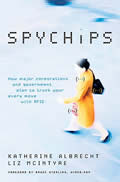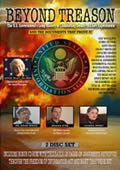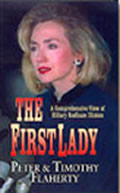LESSER
OF TWO EVILS
PART 2 of 2
By Jon Christian Ryter
September 17, 2008
NewsWithViews.com
Like it or not, you now have a very real clear and candidly honest explanation of how the US political system actually works. The Founding Fathers didn't plan it that way. The money barons behind the party system did. The system mandates voting for the "lesser-of-two-evils"—because one of the two major party candidates is always going to win. That's why our political system is called "the two-party system." It wasn't named that because we only have two political parties since, clearly, we have many more than that. It was called the "two-party system" because, at the top of the ticket (indulge me while I repeat myself) only one of the two major party candidates can win—always!. Third party candidates (those who are graced with any meaningful media coverage) are the designated sieves whose job it is to drain off enough votes from the "lesser-of-two-evils" to guarantee that the "greater-of-two-evils" (i.e., those more snugly in bed with the barons of banking and business and the princes of industry) gets elected.
How do you change it? You must change the system from within by starting at the local level and electing mayors, city council members, county commissioners, then state legislators and governors. Once the people create a new political "foundation," they are ready build a political party by electing congressmen and senators—and, ultimately, presidents. In other words, "party building" begins from the bottom up. When you build a house, you don't start with the roof, you start with the basement.
When the GOP kicked off the Republican National Convention at the Xcel Energy Center in St. Paul on Sept. 1, 2008 disgruntled Ron Paul supporters, anti-Fed, anti-government, anti-tax anarchists and patriot movement activists met for an "alternative agenda" rally at the Target Center in Minneapolis a day later. Promoters of the rally claim they sold over 10 thousand tickets to the 7,500 seat auditorium, but according to the media that was counting, many of the seats remained empty throughout the rally, even when the rally's superstar, Dr. Paul, spoke.
Dr. Paul's "Rally for the Republic" pledged to bring the Republican Party back to its roots. In his speech, Dr. Paul called for an end to the income tax, the Federal Reserve and, he said, the military draft, which was suspended in April, 1975. (In 1980, President Jimmy Carter reinstated draft registration by Executive Order.) Several Republican delegates skipped the speechmaking at the GOP convention to attend the Rally for the Republic" When he spoke, former Minnesota Gov. Jesse Ventura told the Paul loyalists that the two major parties were destroying the nation. The speakers denounced the use of paper money, the "Orwellian policies" of the current administration, the Federal Reserve, its chairman, and the war on drugs.
When you want to create a new political party structure within a two-party system you have to destroy one of the two parties already within that system to accomplish your task. Dr. Paul's Rally for the Republic" was not a wake-up call to revitalize the Republican Party, it was the opening salvo to destroy it from within by urging conservatives to desert the GOP standard-bearer and vote for third party candidates—Constitution Party Chuck Baldwin, Libertarian candidate Bob Barr, or Green Party candidates Ralph Nader or Cynthia McKinney. (Ron Paul made it clear it didn't matter which third party candidate they voted for since he knew none of them can win.) After all, you can't bake a cake until you break a couple of eggs. After the sweepers cleaned away the dregs of confetti and busted balloons from the floors of the Target Center and the Xcel Energy Center, the Ron Paul loyalists returned to their homes and tucked away their latest memories in scrapbooks and electronic images on their computers, content in the knowledge that the Ron Paul Revolution was alive and well.
The Palin-surge changed everyone's campaign tactics. In fact, Gov. Sarah Palin changed the entire dynamics of the election. The response by disgruntled and disillusioned Republicans, self-described Independents, moderate Democrats who were displeased with both Democratic nominee Barack Obama and GOP nominee McCain, and most of all, women of every stripe, was as instantaneous as it was overwhelming. Overnight the Palin Phenomenon catapulted the McCain-Palin team into the lead. The Palin-surge was not a convention bump. It was the reincarnation of the Reagan Revolution. As Obama's post-convention bounce died like a concrete basketball, a Washington Post-ABC News poll showed McCain-Palin surging from a 19 point deficit to a plus 7-point lead in the key battleground States. ABC News reported a 20-point swing towards McCain-Palin among white women. USA Today-Gallup showed Palin brought the ticket a 10-point advantage from likely voters. Polling from every source shows an incredible trend favoring McCain-Palin.
Prior to Palin, thousands of conservative voters (who sat out the Election of 2006 and allowed Congress to fall into the hands of the far left) decided, once again to either sit out the election or cast a meaningless protest vote for change in some other election some other time by voting for one third party candidate or another, knowing it would allow the far left to get an even tighter grip on Congress, and allow the far left to implement any draconian, totalitarian legislation it wants, without debate or compromise from the other side of the aisle.
By Friday, Aug. 29—the weekend before the GOP Convention, the Palin Phenomenon had taken hold. Obama's bounce dribbled out of the gate, and if you wanted to catch the bouncing ball, you would have had to reach down and pick it up off the floor. As Obama-Biden tried to breathe buoyancy into a bubble that had already burst, the "Rally for the Republic" discovered their foot soldiers were already marching to the beat of a different drum from within the Republican Party.
Ron Paul supporters, who also saw the reincarnation of Reagan in Sarah Palin, were sending checks and pledging to support the McCain-Palin ticket. The base of disenfranchised Republican or, at least, conservative voters were thinning out. Dr. Paul's claim that his loyal supporters "...represent a majority of the American people. We deserve to be in the debates," was a little thin. In reality, in 2004 the Constitution Party, with Baltimore lawyer Michael Peroutka heading the ticket and preacher Chuck Baldwin as his running mate, pulled 134 thousand votes nationwide. The Libertarian Party took around 438 thousand votes nationwide. Nader, clustered 464 thousand votes in 2004 running on both the Reform Party and Green Party tickets. Looking at these three tickets from 2004, the third candidates collectively took approximately 1,036,000 votes. This year, because of Sarah Palin, they will take somewhat less. Dr. Paul insists the independents who will cast their votes for all of the third party candidates, collectively, will be between 2 million and 3 million people. His numbers are pure hyperbole based on speculation and not statistics.
















